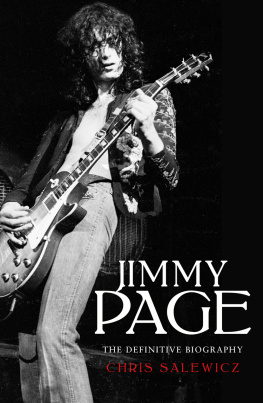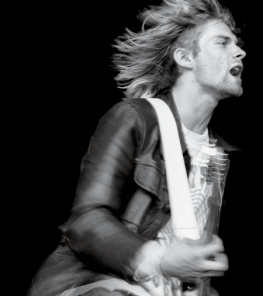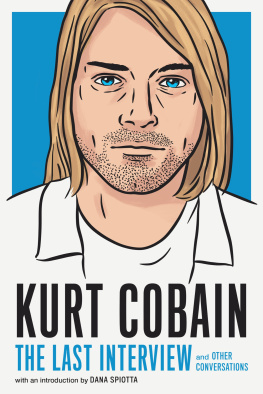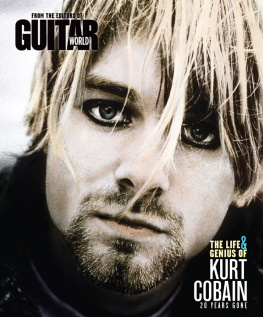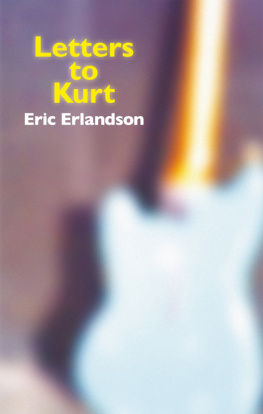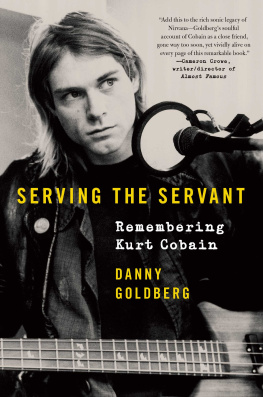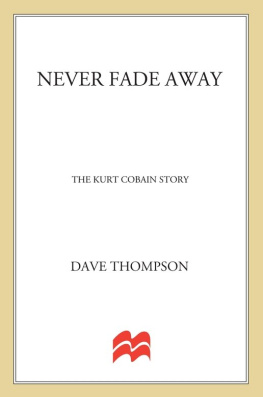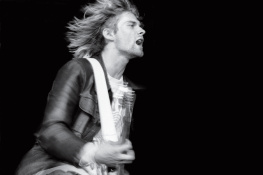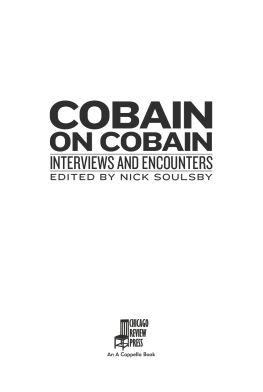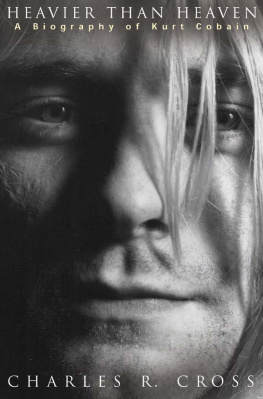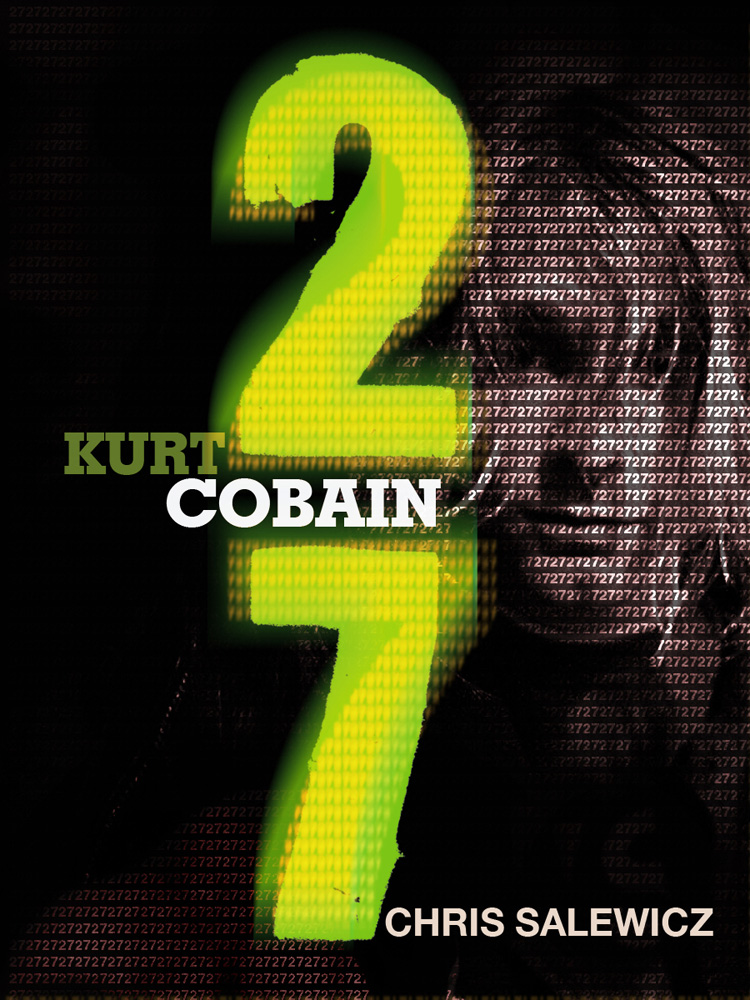27: Kurt Cobain
Chris Salewicz
This ebook edition published in 2012 by
Quercus
55 Baker Street
Seventh Floor, South Block
London
W1U 8EW
Copyright 2012 Quercus Editions Ltd
The moral right of Chris Salewicz to be
identified as the author of this work has been
asserted in accordance with the Copyright,
Designs and Patents Act, 1988.
All rights reserved. No part of this publication
may be reproduced or transmitted in any form
or by any means, electronic or mechanical,
including photocopy, recording, or any
information storage and retrieval system,
without permission in writing from the publisher.
A CIP catalogue record for this book is available from the British Library
ISBN 978 1 78087 538 5
You can find this and many other great books at:
www.quercusbooks.co.uk
Chris Salewicz has been writing about music and pop culture for over 30 years. He was at the NME in the late 1970s and early 1980s and has written for The Sunday Times, The Face and Q magazine. His critically acclaimed books include Bob Marley: The Untold Story, Mick and Keith: Parallel Lines and Redemption Song: The Ballad of Joe Strummer.
Now hes gone and joined that stupid club: I told him not to join that stupid club.
And so Wendy OConnor, the mother of Kurt Cobain, reacted to the news of her sons self-inflicted death on 8 April 1994.
By stupid club, OConnor meant the phenomenon of musical stars who had passed away as had her son at the age of twenty-seven, as though they were unable to cross that bridge into full adulthood that lies ahead of all of us in our late twenties. Other members of Wendy OConnors club included the Rolling Stones Brian Jones, the Doors Jim Morrison, Janis Joplin and Jimi Hendrix like Kurt Cobain, another left-handed guitar player from Americas Pacific North-West, who also revolutionized the music scene while fronting a power-trio.
Kurt Cobain was not the first male member of his family to kill himself. So matter of course was suicide on both sides of his family that, as a young teenager, Kurt would joke of having suicide genes.
When the future Nirvana singer was twelve years old, Burle Cobain, his great-uncle, brother to Kurts grandfather Leland, took a pistol and shot himself, first in the stomach and then in the head, finally killing himself. A year previously, ignoring medical advice that he would face death if he did not give up alcohol, Ernest Cobain, Leland and Burles brother, had fallen on the stairs in his house while drunk, dying from a brain aneurysm some form of subconscious suicide, perhaps. (Aneurysm would become the title of a 1991 Nirvana song, the B-side of Smells Like Teen Spirit; however, there seems little link to Ernest Cobains tragic fate Charles R. Cross, Cobains biographer, asserts that Kurt wrote the lyrics to Aneurysm about his ex-girlfriend, musician Tobi Vail.)
On his mother Wendys side, Kurts great-grandfather had stabbed himself in front of the entire family. Admitted to a mental hospital, he finally killed himself two months later by tearing apart his healing wounds.
It must have seemed almost an everyday occurrence, when, as an early teenager, Kurt and a pair of friends found the hanging body of a boy who had killed himself. So, you are inclined to muse, was Kurts end inevitable?
Surviving members of families in which suicide has occurred are frequently haunted by the fear that it runs in the family, that one day they too might take their own lives. Mental health problems run in many families, and it is worth recalling that the third single off Nevermind was Lithium, a song that took the name of the drug that allegedly treated manic-depressive bi-polar, as it became termed behaviour. This was an affliction from which Kurt certainly suffered, though it is not known whether he ever took lithium.
Yet tragedy in the family can act as a spur for other members. Was this the case with this highly sensitive and intelligent, innately artistic boy who would utterly change the course of 1990s music?
In 1991 Nirvana revealed themselves as the last Great American Rock Band, one which emerged seemingly from nowhere to sell over 30 million copies of Nevermind. Nirvana are as indelibly the sound of Americas West Coast as the Beach Boys, but this is a different West Coast, marinaded in rain, mist and darkness. In the vanguard of what became known as the grunge movement, the sludgy fusion of punk rock and heavy metal that emerged from the Pacific Northwest, Nirvanas seemingly sudden success overturned the American music business. Until then, alternative music had seemed marginal at best in its sales potential, but now it was evident that there was a critical mass of fans apparently waiting for just such an act to materialize. Nirvana shook the world with their music. Their explosive arrival opened the floodgates for acts previously marginalized as part of Americas resolutely independent music scene. Several such bands became part of the most exciting movement since punk fifteen years previously, of which Nirvana were direct descendants. REM already frontrunners Pearl Jam, Smashing Pumpkins, Dinosaur Jr., Rage Against the Machine, Screaming Trees, Janes Addiction, and for Kurt, the spiritual godfathers Sonic Youth, now swept all before them.
Not only was Kurt Cobain the most successful musician of his generation, he was the rock n roll god of his age: a rock star, a father, an anti-style icon, a junkie, a suicide. Yet his was also the story of what happens to a man when he gets what he wants.
Kurt took the universal pain of a child of divorce and expressed it (the parents of Nirvana bassist Krist Novoselic and drummer Dave Grohl had also split up). His persistent feelings of utter isolation were so archetypal that he managed to truly connect with an enormous audience. Kurt seemed an almost professional loser, which was why he became such a huge star. Everyone identified with him and his struggle to be himself. Yet there was always an element of pose, and although Kurt Cobain seemed the personification of what would soon become known as Generation X slacker apathy, he was also a very good actor. He was largely content to go along with anything that could boost his success, perfectly prepared to sign with a major label, to ditch an inappropriate drummer, and to accept huge pay cheques for playing major festivals. Yet he was persistently conflicted over his role as a star, uncomfortable with the financial rewards it brought.
Nirvana were a punk act that drew on the spirit of the Sex Pistols Never Mind the Bollocks, on the churning drive of Led Zeppelin and Black Sabbath, and on the melodic possibilities of the Beatles, with whose music Kurt had grown up. Many of his relatives loved the English group. My aunts would give me Beatles records, he told Jon Savage. For the most part it was just Beatles records. In fact, many of Kurts influences were from the UK. Appropriately, at the end of 1991, when Nevermind was surging up the US charts, Nirvana were touring Britain and then Europe, largely unaware that their lives were about to be utterly transformed.
An anti-hero figurehead for his generation in his moth-holed thrift store woollen apparel, in January 1992 Kurt Cobain and Nirvana dislodged Michael Jacksons Dangerous album from its long stint at the top of the US album charts. As a cultural figure, Kurt represented a very specific moment when a unique sense of community the global Nirvana community emerged from popular culture. The early 1990s were a period of recession and war, both in the Gulf and the former Yugoslavia, and Kurts hand-me-down garb was the antithesis of the designer-besotted late 1980s. His rebel music bespoke the soul of a difficult, dysfunctional individual, which was precisely the interior landscape of many of his fans.


